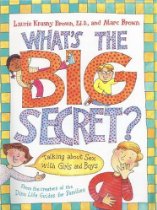
What strikes me in the media's coverage of this story are the select quotations and presentation of the book:
"[The book] includes cartoons explaining masturbation" and "cartoon characters discussing the feeling you can get from ‘rubbing your genitals’ and shows a young boy telling a girl, ‘I’ll show you mine.’"(Mail Online)
"[The book] shows how boys and girls are physically different, offers a lesson in reproduction and "talks about 'different types of touching.'" (Q13 FOX News)
Taken out of context, you might begin to think that the book is indeed very graphic. - But it's not. The illustrations that accompany the page about touching yourself feature a boy snuggled up on a couch beneath a blanket (with both hands on top of the blanket), a girl washing her hands, a bald man combing his long beard, a cat licking its paw, and a "do not disturb" sign held up by a person behind a changing curtain. The text reads:
Enjoying your body and the way it feels is an important part of being alive, no matter how old you are. Some parts of your body are more sensitive than others; do you feel more when you touch your elbow or your lips?
Touching and rubbing your genitals to feel good is called masturbation. Some of us try this; some of us don't. However, it's best to do this private kind of touching off by yourself. (16)
The book's further discussion of different kinds of touching is crucial:
Everyone needs good touches to feel loved an happy. If you want a hug, you can say so. But no one has the right to touch you in a way that feels wrong or uncomfortable. (19)
Whoever you touch has feelings too. If someone doesn't want to be touched, then respect his or her wishes – don't do it! (17)
 For other types of touches, the book refers to hugging your parents, wrestling with a friend, shaking your teacher's hand, and a baby being held and cuddled.
For other types of touches, the book refers to hugging your parents, wrestling with a friend, shaking your teacher's hand, and a baby being held and cuddled.The boy telling a girl, "I'll show you mine," is acting the patient in a game of Playing Doctor, which as Haffner points out is a common sex play between children, indicating "expected and natural childhood sexual curiosity" and not a desire for "erotic fulfillment" (56-57).
In fact, some sexologists even believe that early childhood sex play teaches children some important skills. They point to studies of monkeys: In monkeys, early (pre-adult) sex play lays the foundation for successful male-female reproduction in adulthood. Monkeys who are raised in isolation, and do not have this opportunity, never copulate or reproduce, even when paired with an experienced mate. (57)

The book also gives a simple lesson on reproduction – hence also the description of why boys and girls are physically different: "the sexual parts of girls and boys are made differently so that when they grow up they are able to create babies and become parents" (20) – as well as on pregnancy and birth.
In response to the mother's complaint, the assistant superintendent told Seattle's Q13 FOX News that the book is available to all ages and has never required a parent's permission:
"This book has been on the shelves for 10 years, at five different elementary schools," Gibbon said ... This is the first time there's been any question about it" ... Gibbon adds that fifth grade is when students in Washington state begin sex-ed classes. He said plenty of people research the material before it is put on the school library shelves. "All of our books are reviewed by staff for age appropriateness [who] look at outside reviewers, their ratings, and quality of materials." If a parent has a concern, the school welcomes discussion and feedback.The Seattle Public Library carries the book as well and reports that the book has received great reviews from the School Library Journal and Publishers Weekly.

0 comments:
Post a Comment